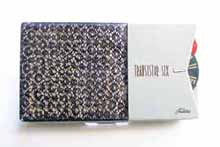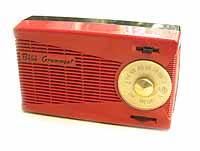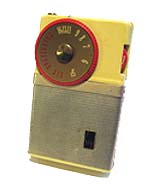Plastics used in transistor radio cabinets:
THERMOSETTING PLASTICS are the older plastics: Bakelite, Catalin, Plaskon (all trademarks), phenolic plastics, and urea-formaldehyde. These plastics are "set" in their production process and cannot be remolded by heat or chemical action. Repairs on cracks can only be done with adhesives and not with solvents. These thermosetting plastics are of course what were used in the manufacture of many tabletop tube radio cabinets in the 1930s and 1940s.
And in the 1950s and early 1960s, thermosetting plastics found their way into the cabinets of Japan-made portable radios, both tube and transistor sets. And while many US tube portable radio cabinets were also made of thermosetting plastics, very few (if any) US or European transistor radios from that era made use of thermosetting plastics. But among early Japanese transistor radios, the 1956 Sony TR-6, 1957 Sony TR-66, c.1957 Kobe Kogyo KT-6/1958 Realistic "High-Fiver", 1958 Toshibas 6TR-186 and 6TR-188, the 1958 National EB-165, the c.1959 National AB-235, the c.1959 Sharp TR-203/Coronado RA50-9907, and the c.1959 Toshiba 6TR-92 "Rice Bowl", to name a few examples, all had cabinets made of thermosetting plastic.
THERMOPLASTIC PLASTICS are the "newer" plastics, the ones developed in the 1940s and perfected in the 1950s: Polystyrene, ABS (Acrylonitrile butadiene styrene), and nylon, to name the most popular. Unlike thermosetting plastics, these plastics are not "set" in their production process, and therefore they can be remolded by heat or chemical action, and repairs on cracks can be made with solvents such as Methyl Ethyl Ketone (MEK) on ABS plastics, though not on nylon. The vast majority of transistor radio cabinets made in the 1950s and early 1960s, beginning with the Regency TR-1, were made of ABS, a compound of polystyrene that is much less brittle than polystyrene itself. Sony's TR-63, TR-86, TR-610 and many later sets all had cabinets made of ABS, as did Standards and Toshibas made after 1958 and most other transistor radios made in 1959 and later. For nylon cabinets, the best known example is the Zenith Royal 500 series.
How to tell what plastic it is:
SOLVENT TEST — Testing by chemical action:
From my experience, this is by far the easiest and most definitive way to differentiate between thermosetting plastics and ABS thermoplastic — sometimes these can be a bit difficult to distinguish one from the other without doing this test.
Dip a Q-Tip in a ketone solvent such as MEK (Methyl Ethyl Ketone) or Acetone and then touch the plastic with it (somewhere inside the cabinet, of course, and as hidden as possible — this will make a permanent mark if the plastic is ABS!):
Thermosetting plastic: no effect
ABS (a thermoplastic): the plastic's surface slightly "melts"
from the chemical reaction
Nylon (a thermoplastic): no effect
(And while nylon and thermosetting plastics react in the same way to ketone solvents (no reaction), the physical difference between them is very obvious both by touch and look — nylon cabinets are much thinner, far more flexible, and much softer to the touch than are thermosetting cabinets.)
"TAP AND FEEL" TEST — Testing by hand:
Tapping: Tap the plastic with your fingernail — a hard and solid sound indicates thermosetting plastic — by comparison, a softer sound indicates thermoplastic plastic (ABS, nylon, etc.)
Feel: Nylon plastic not only has a much softer feel to its surface than do standard thermoplastics such as ABS but it's also more flexible.
Even softer to the touch than nylon is Cellulose Acetate Butyrate, a plastic that Emerson used on its 555 radio cabinets and very likely on its 888-series cabinets as well.
JUST LOOK AT IT:
Because of the production mold process, cabinets made of thermosetting plastic are a bit thicker than those made of thermoplastic, and their corners are typically more rounded, less sharp-angled.
Repairing cracks and deformations in thermoplastic cabinets:
REPAIRING DEFORMATIONS IN THERMOPLASTIC CABINETS (NYLON AND ABS):
Because nylon and ABS are thermoplastic, they can be remolded by heat. If a cabinet has warped, applying heat from a hair dryer or heat lamp can allow the plastic to be manipulated back into its original shape.
REPAIRING CRACKS IN ABS CABINETS:
The best way to repair cracks in ABS plastic is not by adhesives such as epoxies or cyanoacrylates (Super Glue, Crazy Glue), but with the ketone solvent Methyl Ethyl Ketone (MEK), commonly available at hardware stores and chemical supply houses. (Acetone is also a ketone solvent, but it's not strong enough for repairing cracks.) As a solvent, MEK melds the two surfaces together and ideally makes the crack disappear — an epoxy glue will leave a trace line unless it's exactly the same color as the plastic, as will Super Glue and all other cyanoacrylates to a lesser extent.
The way in which MEK is applied to the crack takes some skill and patience: MEK is a very strong solvent that will "melt" any ABS plastic surface, so it can only be applied to the crack itself. This is done by capillary action, in which a tiny amount of fluid is drawn into the crack without affecting the surrounding plastic surface.
I've found the best way to do this is by dipping the tip of a pin or needle into the MEK so that a tiny drop of MEK then hangs off the tip — this is then touched directly onto the crack, where "capillary action" will then draw the MEK into the crack without any of the MEK attacking the surrounding plastic. Several drops administered this way may be needed.
(I recommend this over the standard advice of using a syringe to apply the solvent, since from my own experience here I've found that it's far too easy for a shaky hand to press too much solvent onto the crack and make a complete mess of the plastic's surface around the crack!)
The crack should be pressed together as tightly as possible before applying the MEK, ideally with a clamp that should be left in place for at least five minutes while the MEK evaporates. A crack longer than a half-inch or so may require several touches of MEK along its length. Some "squeeze-out" residue is typical, and this can be sanded off and polished.
Hydrogen peroxide and UV light for color restoration (ABS plastic only?):
The combination of a hydrogen peroxide bath and a catalyst of ultraviolet light (sunlight works just fine here) is a safe and simple way to return yellowed ABS plastic to its original color. (It's possible that this works on all colors, not just white, but I haven't really explored that.) The only hitch here is acquiring industrial-grade hydrogen peroxide (25% H2O2), which you can get from an industrial chemical supply house or maybe your local hardware store — the 3% hydrogen peroxide solution that you'll find at your local pharmacy isn't strong enough for the process.
PLEASE NOTE: USE THIS TREATMENT ONLY ON THE PLASTIC ITSELF: Do NOT use it on plastic which has anything on it that cannot be removed, such as painted lettering, brass trim, paper labels, etc.
PLEASE NOTE: DO NOT USE THIS TREATMENT ON NYLON CABINETS (Zenith Royal 500 series, TED Bebe Grammont). Nylon is not compatible with hydrogen peroxide and most likely will discolor if exposed to it.
Also, since I have not tried this treatment on thermosetting plastics, I WOULD NOT RECOMMEND using it on thermosetting plastics such as those found on cabinets of some early Japanese transistor radios and mini-tube radios. Maybe it works just fine, but you should first test it on a scrap piece of thermosetting plastic. (Someday I should get around to doing this myself, and then I'll update this page!)
(The OzoneLab Instruments page, "Material Compatibility with Hydrogen Peroxide (H2O2)", shows ABS to be completely compatible with hydrogen peroxide but nylon to be incompatible with hydrogen peroxide. The page doesn't cover the earlier thermosetting plastics such as Bakelite and phenolic resins.)
What I've found to work best is a 25% H2O2 solution diluted about half with water. The process here is about as simple as it gets: Put the plastic in a bath of peroxide solution and leave it exposed to sunlight or a UV lamp for a day or two — the longer you leave it in the solution, the closer it returns to its original color. After some time the peroxide will have spent itself — "overdoing" the process isn't possible.
Is this safe? Yes, but only on certain plastics, such as ABS. The peroxide is doing nothing more than removing oxidation. BUT NOTE: USE THIS TREATMENT ONLY ON THE PLASTIC ITSELF: Do NOT use it on plastic which has anything on it that cannot be removed, such as painted lettering, brass trim, paper labels, etc.
|







